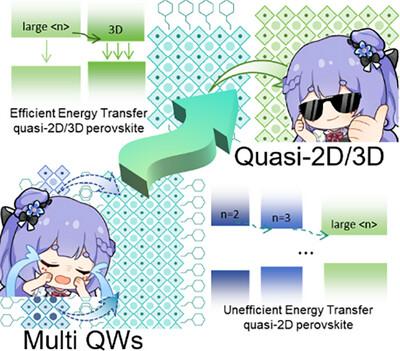准二维/三维钙钛矿低阈值放大自发辐射的工程能量级联
IF 10
1区 物理与天体物理
Q1 OPTICS
引用次数: 0
摘要
金属卤化物钙钛矿,特别是准二维钙钛矿,由于其优异的光电性能,已成为下一代激光二极管增益介质的有希望的候选者。然而,传统的准二维钙钛矿在高载流子密度下存在低效的激子漏斗和明显的效率滚降。本文提出了一种准2d /3D钙钛矿结构,该结构具有高效的能量级联,通过分子工程策略进行调节。PEO中的C─O─C官能团与PEA+形成氢键,从而延缓了PEA+与[PbBr6]4−八面体无机层的组装。这种改性导致了晶粒尺寸的细化,结晶度的增强,并改善了所得薄膜的表面平整度。此外,设计的准2d /3D薄膜显示出更高的激子结合能,同时减轻了高载流子密度下的效率滚降,这是通过从准2d相到3D相的定向能量传递有效地抑制了俄歇复合实现的。因此,准2d /3D薄膜的放大自发发射阈值降低到16.6µJ cm−2,并获得更高的净模态增益系数(892 cm−1)。这些发现为开发低阈值钙钛矿激光器提供了重要的见解。本文章由计算机程序翻译,如有差异,请以英文原文为准。

Engineering Energy Cascades in Quasi-2D/3D Perovskites Toward Low-Threshold Amplified Spontaneous Emission
Metal halide perovskites, particularly quasi-2D perovskites, have emerged as promising candidates for next-generation laser diode gain media due to their exceptional optoelectronic properties. However, conventional quasi-2D perovskites suffer from inefficient exciton funneling and pronounced efficiency roll-off at high carrier densities. Here, a quasi-2D/3D perovskite structure is proposed with a high-efficient energy cascade, modulated through molecular engineering strategy. The C─O─C functional groups in PEO form hydrogen bonds with PEA+, thereby delaying the assembly of PEA+ with the [PbBr6]4− octahedra inorganic layer. This modification led to refined grain size, enhanced crystallinity, and improved surface flatness in the resulting films. Furthermore, the engineered quasi-2D/3D thin film exhibits an increased exciton binding energy while alleviating efficiency roll-off at high carrier density, achieved by effectively suppressing Auger recombination through directional energy transfer from the quasi-2D to the 3D phase. Consequently, the amplified spontaneous emission threshold of quasi-2D/3D films is reduced to 16.6 µJ cm−2, and obtained a higher net modal gain coefficient (892 cm−1). These findings provide critical insights for developing low-threshold perovskite lasers.
求助全文
通过发布文献求助,成功后即可免费获取论文全文。
去求助
来源期刊
CiteScore
14.20
自引率
5.50%
发文量
314
审稿时长
2 months
期刊介绍:
Laser & Photonics Reviews is a reputable journal that publishes high-quality Reviews, original Research Articles, and Perspectives in the field of photonics and optics. It covers both theoretical and experimental aspects, including recent groundbreaking research, specific advancements, and innovative applications.
As evidence of its impact and recognition, Laser & Photonics Reviews boasts a remarkable 2022 Impact Factor of 11.0, according to the Journal Citation Reports from Clarivate Analytics (2023). Moreover, it holds impressive rankings in the InCites Journal Citation Reports: in 2021, it was ranked 6th out of 101 in the field of Optics, 15th out of 161 in Applied Physics, and 12th out of 69 in Condensed Matter Physics.
The journal uses the ISSN numbers 1863-8880 for print and 1863-8899 for online publications.

 求助内容:
求助内容: 应助结果提醒方式:
应助结果提醒方式:


